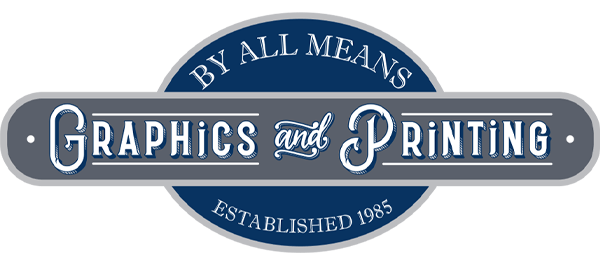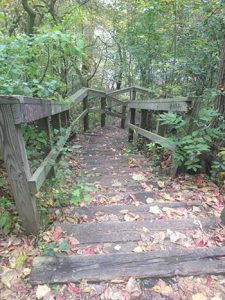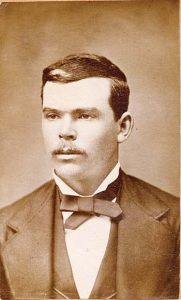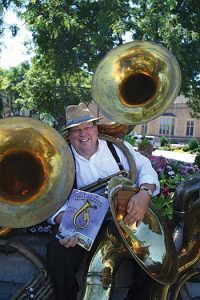
In 1855, at the age of 40, John Wesley North was ready for new challenges. A New Yorker by birth, he had moved to St. Anthony in 1849, established a law office and was an active member of the Minnesota territorial legislature. But he found himself captivated by the Cannon River Valley, finding it “beautiful and very fertile,” with seasons two weeks earlier than St. Anthony. “The crab-apple and wild plum grow there in abundance and furnish fruit to the settlers,” he wrote. North considered prospects at Faribault, but a site 15 miles further north on the Cannon River attracted his attention as a mill site, which could provide economic stability. Soon a local resident named Mr. Alexander, at the behest of North, was calling a meeting of the neighbors at which “each was requested to state what he could do or would do, and in a short time a plan of operations was agreed on for building the saw mill, a grist mill, and a bridge – the two mills are to be on opposite sides of the stream,” according to Merlin Stonehouse’s biography, “John Wesley North and the Reform Frontier” (1965).
The town was platted and the sawmill completed in December of 1855. The next month, in 44-below weather, North brought his wife Ann and three children to the town in a sleigh drawn by a four-horse team, a journey that took a day and a half from St. Anthony. They settled in an 18′ x 30′ house with a 10′ x 30′ lean-to, heated by three stoves, and on Jan. 6, North wrote in his first letter of the new year, “We are here comfortably settled in our new home, which you may have heard before this bears the euphonious cognomen of Northfield.”
North soon held a public meeting at which 20 men contributed almost $300 for a schoolhouse suitable also for religious services. By springtime, Northfield had a 40-foot store, shops for two wheelwrights, a cabinetmaker, joiner and a blacksmith. John and Ann North wrote frequent “puffing letters” to friends in New England, extolling the town’s virtues and attracting immigrants. As Stonehouse wrote, these new residents were “mostly Republican, committed to temperance, abolition and education.”
There was plenty of physical stimulation provided by the pioneer environment, but stimulation for the mind had to be created. And North wasted no time in putting together the Northfield Lyceum for this purpose. (The word “lyceum” comes from the name of the grove at Athens where Aristotle taught and is defined as a place or organization for public lectures or discussions.)
The first meeting was held in the schoolhouse on Oct. 1, 1856, and a constitution was written thereafter, starting with the words: “Believing in the utility of societies for intellectual improvement, we, citizens of Northfield, agree to unite ourselves into an association for the purpose of establishing a reading room, circulating library and debating society.”
John W. North was the first president and on April 1, 1857, he appointed a committee to receive proposals for constructing the Lyceum’s own building. On April 15, North himself provided the site for an 18′ x 28′ structure, offering to contribute the balance toward the $580 erection price if the town could raise $400. The fund-raising was successful, and the first meeting of the Lyceum in this modest frame building at 109 East 4th St. was held on Nov. 4, 1857. (At times, the building was also used for church meetings.)
Each Wednesday evening, two people debated a topic, which was then discussed by all. Stonehouse wrote that at times it was “hard to organize a true debate; the situation became humorous when North was delegated to defend slavery.” Carl Weicht, long-time Northfield News editor, wrote that at a time when “Northfield was little more than a name and a few scattered dwellings,” this was to be not to be “just another club,” but “a community center, chamber of commerce and public forum all in one. And during the formative years of Northfield’s life, it was all of these things.”
One of the early debate topics was: “Resolved, that woman is entitled to all the rights, social and political, to which man is entitled.” The minutes recorded an affirmative decision, “the ladies assisting in voting.” Lyceum treasurer Hiram Scriver, the leading merchant in town who became the first mayor and a trustee of Carleton College, said in a speech in 1876, “Thus early did this great question agitate the minds and hearts of the community. It was difficult to find anybody to take the negative, for the male sex especially felt that the great necessity of the house was for the immigration of the fairer sex. Young men and bachelors, therefore, were spoiling to have women vote, and every inducement was offered to get them here.”
Other topics: Resolved, “that war is never under any circumstances justifiable” (passed by a large majority); “that lawyers and statesmen have achieved greater triumphs of eloquence than preachers;” “that dancing is a proper amusement of young people” (carried 20 to 3, “after its discussion socially and politically from Adam to our progenitors”); “that capital punishment should be abolished;” “that the cause of temperance is not promoted otherwise than by moral suasion;” “that religious creeds have been productive of more evil than good” (“carried in the affirmative by a crowded house, but decided in the negative by the members of the society”); “that the pulpit has done more for civilization than the press” (“decided in the negative, but upon further consideration, and a fuller vote, it was decided in the affirmative, the ladies voting unanimously that way”); and “that it is morally wrong for the members of the Lyceum to neglect to speak at its meetings.”
Parliamentary rules were observed. North suggested that a critic be chosen to “point out and correct such errors of language and manner as he may have noticed during the meeting.” There were lectures from time to time and music to open and close meetings (“Our choir reflects great credit on the musical ability of Northfield,” said one entry in the minutes). There were also readings from the Lyceum newspaper, the Portfolio.
Northfield’s first library was housed in the Lyceum and, by the end of 1858, more than 300 books had been contributed, many of them donated by the town’s founder. (A set of North’s books is still owned by the Northfield Public Library.) From the beginning, $50 had been allocated for periodicals such as Harper’s, the Atlantic Monthly, the Edinburgh and London Reviews, the Home Journal, Punch and the New York Times to bring news of the outside world to the town.
The exigencies of the Civil War and the creation of more social opportunities through churches and other organizations led to the gradual demise of the Lyceum. There were various attempts to reorganize it, with emphasis on its utility as a reading room and place for lectures.
News items in the Rice County Journal trace a decline in membership from 100 in 1874 to only 27 in 1877. On Sept. 27, 1877, the headline was “A Bankrupt Institution” and the writer said, “Complaints are already made that the Reading Room is continually begging, and some of our people seem to be bored by the frequent visits of committees soliciting in its behalf.” A plan was devised for 50 “responsible citizens” to subscribe $5 each annually, with “one of Northfield’s attractive and popular young ladies” volunteering to collect signatures. But the attempt failed.
In 1878, the ownership of the building, including the library, was transferred to the city. The library was said to be in “disorderly confusion” and no record had been kept of books taken out for two years. One minor but continual annoyance: boys had been stealing the rubber bands from the newspapers and “running wild with sling-shot made of rubber.”
In 1884, the building was rotated 90 degrees to face Fourth Street rather than the Cannon River. Dr. William Greaves had his medical offices in the Lyceum building and, in 1885, rented out part of it for a photograph gallery for E.N. James.
The building also has been used as a private residence. In 1933, it was front page news when the Lyceum building was the scene of a liquor raid by the sheriff and local police. The Northfield News article of Jan. 20 proclaimed that the Lyceum building has “come upon evil days.” Martin Ackman, who had been occupying the house for only a short time, was arrested for selling liquor to students. Ackman was sentenced to 90 days in county jail, in lieu of a fine of $100 and costs. The article recalled that North had written into every deed for property in the original town that “no intoxicating drinks be sold or in any manner furnished as a beverage on said premises.”
The building was occupied by Wood’s Hatchery for six years 1934-1940. In 1937, Northfield plumbing and heating engineer C.M. Grastvedt purchased the building from the estate of Clarence Carpenter. And in 1943, the Lyceum Building began its over half a century history as a dental office when Dr. Leonard Amodt purchased the building. Drs. Frederick and Elvin F. Heiberg brought their own dental practices to the Lyceum when they bought it from the Amodt estate in 1964. The elder Heiberg retired in 1966 and his son carried on his own practice until 1997. Elvin Heiberg conferred with architectural designer and historian Robert Warn in 1973 and restored the Lyceum closer to its original appearance, including removing a log cabin siding.
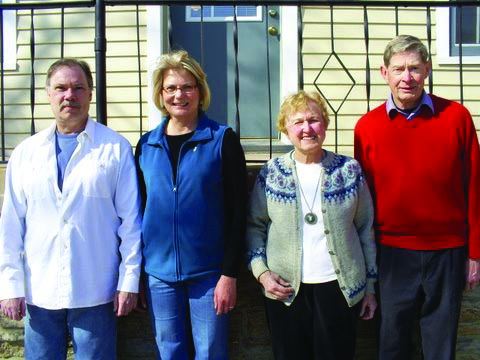
Agu and Mary Lukk used the building for their investment firm and remodeled it further when they purchased it from Elvin and Corrine Heiberg in 1997. They painted the building yellow with a white frame and blue cornices. Since 2002, the Lyceum building has provided office space for attorney James H. Johnson and his wife Mary Kathleen Fransen who runs the Jasper Retreat Center. They have kept historic paint combinations and are happy to be curators of a building with such a rich local history.
The Heibergs say they also feel privileged to have been the owners of this historic building. Their 33 years of ownership were the longest in the more than 150 years of the Lyceum Building’s existence and they hope that the Lyceum will continue to be part of Northfield’s history for many years to come.
Thanks to the Northfield Historical Society archives, the Northfield Public Library for newspaper microfilms and James Johnson, Mary Fransen and Elvin and Corrine Heiberg for their cooperation and dedication to the history of the Lyceum.
Microfilms of the minutes of the early years of the Lyceum from the Minnesota State Historical Society are now available at the Northfield Public Library. These minutes were donated to the Rice County Historical Society by Carl Weicht in 1942.

